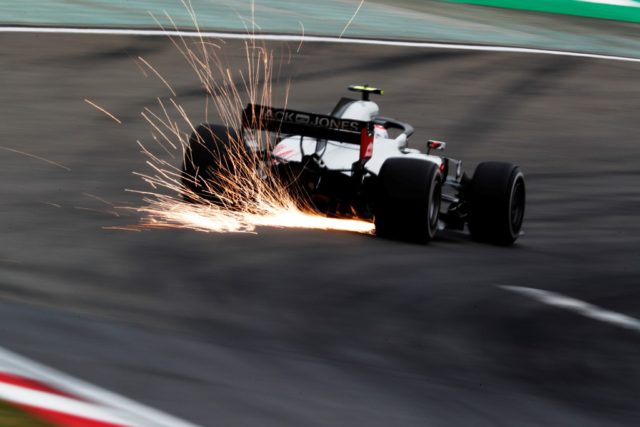The Austrian Grand prix marks the 50th Grand prix for Haas. Team principal Guenther Steiner previews the race and reflects on the American equipe’s achievements.
Austria marks Haas F1 Team’s milestone 50th grand prix. Considering this team was built from scratch and there were doubts by some that it would actually make it to the grid in 2016, how satisfying is it to hit this milestone while also fighting among the top teams of the midfield?
“You don’t realize it’s already our 50th grand prix with Haas F1 Team. Time goes by quick in life in general, but in F1 I think it goes even quicker. We can be proud with what we’ve achieved, we just need to get more points from this season. We have a very good car where we can be the best of the rest, and we need to convert that into points so that at the end of the season, we are the best of the rest.”
You predicted that the pace you had in Canada would carry over to France. That seemed to be the case, and it seems to have given you a more real-world understanding of the updates the team brought to the Haas VF-18 in Canada. How has the car performed and what do you think that portends for the Austrian Grand Prix?
“We saw the potential of the upgrade in Canada, but we literally just couldn’t use it at its full extent because of the start positions. On the data though, we saw that the upgrade was working and, obviously, we proved that in France by qualifying with both cars in the top-10 and in the race with Kevin (Magnussen) finishing sixth. Going to Austria, we are confident that it will work as it did in France.”
How helpful is it to have back-to-back grands prix where the same tire compounds are being used? Or in this case, is there carryover in tire data between France and Austria since the tires used in France were thinner compared to the ones you’ll use in Austria?
“Back-to-back races with the same tires –it’s difficult to say it’s an advantage because the track surface is different and you use the tires differently. We use the tires we get as best as we can and try to get the most out of them.”
The Austrian Grand Prix marks the middle of an unprecedented three-race stretch. What are your thoughts on this batch of races, and how do team personnel balance the travel and time at the track with their home life?
“It’s difficult to balance for them. We try to get some of the guys home between races. The good thing is that the third grand prix is Silverstone, so for our race team, it’s close to our Banbury base. It’s different for the teams based in mainland Europe – they’re away from home. Most of our personnel who work in England live somewhere near the factory, which is near Silverstone, so they can at least see their families.
“Otherwise, it’s not easy to handle, but we will see. We’ve never done it before, so we’ll see how it comes out. I think because we are a small team, if not the smallest, we are the easiest to move around with all of our equipment. The bigger teams have the big motorhomes, and for them, it’s even more difficult than for us. Nevertheless, we will know more in about two weeks and how it impacted our personnel.”
Guess what? It’s race week yet again! #AustrianGP, you’re up! ? pic.twitter.com/ardTI2OG5g
— Haas F1 Team (@HaasF1Team) June 25, 2018
There is talk of increasing the number of races on the Formula One calendar, exceeding the current slate of 21 races. What is your take on the number of races in Formula One, and do you have an ideal number in mind?
“I don’t think there is an ideal number, and I don’t think the plan is to increase it a lot. I don’t think we should increase it if there is no financial gain for it. If there is a financial upside to it, we can plan better with exchanging people, or send them home after, or send some people out earlier and home later, or something like that – we can deal with it. But if we have the same amount of money and we just do more, we are working a lot more for the same amount of money, which means you’re getting less.
“Nobody is striving hard to get less, so we need to keep that in mind. Also, I think we need to be careful that we’re not oversaturating the people which are interested in Formula One. If we have a grand prix every weekend, it’s not news anymore. Liberty Media is well aware of these elements of it, and they will handle it accordingly.”
There is also talk of tweaking the format of race weekends. What have you heard, and how would any kind of change impact the current processes you have in place to prepare the car and team for practice, qualifying and the race?
“Different parties have different opinions and objectives. The promoters like to have us at the racetrack on a Friday running around because the people show up and want to watch us. If we just do a Saturday and Sunday event, somebody will not be happy – maybe the promoters, which I understand. Otherwise, it’s very difficult to tweak the weekend. To cut a day out, it’s the only saving you could make. It was mentioned to have a sprint race on Saturday, but I think that’s an idea that’s already in the past. Qualifying is still a very integral and interesting part of Formula One on a Saturday afternoon. If we just start on Saturday, and maybe have two sessions then qualifying in the afternoon, we could go racing on Sunday.
“I cannot comment if a sprint race is off the table completely, but I don’t favour to race on Saturdays. First of all, it eats into our race on Sunday. If we have two races, it has a diminishing effect on the Sunday race because you’ve already had one on Saturday. That’s why qualifying is an event in itself. It’s a very exciting, emotional event, and a very good one.
“It’s also not only that you could have damage, you need to have double the amount of spare parts around, and you need to have them as you’re doing two races. The chance of having damage is much higher. It’s double than just having one race. You need to make sure you’ve got enough spares for two races. The transport costs would be huge, to just send around all the material, and all the investment in parts would be a lot higher. I don’t know if it is off the table, but it’s not something I’m in favour of.”
 The United States is on track to have two Formula One races in 2019 with the potential addition of the Miami Grand Prix. What are your thoughts on a second Formula One race in America? Does it help Haas F1 Team in the sense that Americans can see more of their home team, and does it also help grow Formula One’s global footprint?
The United States is on track to have two Formula One races in 2019 with the potential addition of the Miami Grand Prix. What are your thoughts on a second Formula One race in America? Does it help Haas F1 Team in the sense that Americans can see more of their home team, and does it also help grow Formula One’s global footprint?
“I think it’s good for the sport to have a bigger North American presence. It’s still the biggest economy in the world. I think we’ve got a little bit more interest in Formula One in America now. I don’t know how much of that we’ve contributed to and how much Liberty Media contributed to, but Formula One in America seems to have a little bit of traction at the moment. A second race would be great, especially at a place like Miami, which should attract international guests and travellers. That’s always good for anybody, having people come from outside.
“By boosting the overall interest in Formula One in North America, Austin will benefit as well, because people who go to Miami also go to Austin, or people who cannot go to Miami will go to Austin instead of Miami. I think it’s a very good thing to have two races in North America, and it would be fantastic for me. It would be the second race for me in the same time zone I’m living in.”
The Red Bull Ring in Spielberg is relatively close to your hometown of Merano, Italy. Do you view it as a home race of sorts?
“Yes, of sorts, but I’ve got many home races in my life. I have one in Austria, one in Italy, which is Monza, and one in the United States. Red Bull Ring is relatively close to where I come from and is only about a five-hour drive from my hometown.”

































